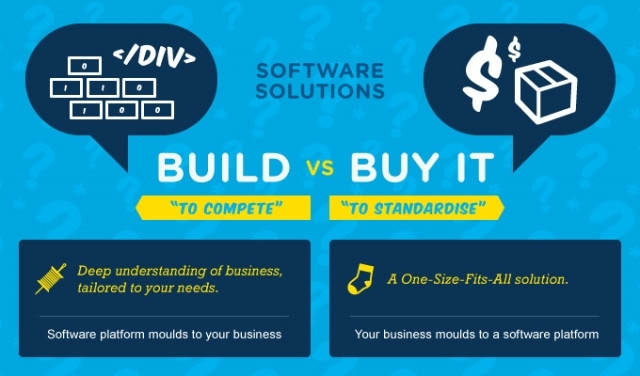
The old axiom "buy to standardise, build to compete" might seem like good advice when deciding whether to buy a package solution that fits your company 75% of the way, versus the investment needed to build a custom solution that is tailored to exactly fit your needs. However, the real questions you need to ask are more complex, says Sarah Meder, staff writer at Saratoga.
Do you understand what it is that needs solving?
Understanding the problem you are trying to solve is key to finding the right answer. Business analysis is the key component used to systematically delve into business needs and technology impact within the business.
Applying deep analytical thinking frequently leads to surprising results, prompting a clear definition of the challenges that need to be addressed and provide a good compass as to which direction to take. More on business analysis as a service.
Can a boxed solution truly meet your needs?
When considering your options, it may seem like a custom solution is akin to reinventing the wheel when so many boxed solutions are on offer. Off-the-shelf products are great for non-critical business processes where 'fit' isn't essential, but there are a few more considerations to keep in mind when choosing this option.
A trial of the boxed solution is essential to making sure it is the right fit for your needs. The trial period can allow a business to see if the product can be customised in the ways needed, and that the current processes in place can fit the new system. Failure to do this can lead to ongoing upgrade costs every time the platform has a version change and, in extreme cases, prevent the organisation from following the vendor-recommended upgrade schedule. An awareness of such hidden costs, including those for integration with existing software, is needed prior to committing to a packaged service.
Do you recognise your competitive advantage?
A company's competitive advantage often stems from the subtle variations in best practice when it comes to their core business processes. When using an off-the-shelf package that forces the business process to fit the platform, these important subtleties can be changed or even lost. Custom solutions, when implemented with a focus on enhancing these core processes, allow the business to retain this competitive advantage while controlling its IT spend by only implementing changes that are truly needed.
General perception is that custom solutions are expensive to build and maintain. Although there's no question that a bespoke solution requires initial capital outlay, exchange rate fluctuations may lessen the cost advantage of a boxed solution over time, and the case may be rendered moot if the vendor is not well capitalised and goes out of business. The cost exposure on a custom solution can also be limited by applying an incremental approach, which leverages the 80/20 principle by delivering a minimal viable product ahead of heavy investment.
Mark Gebhardt oversees Saratoga's software delivery capability in large enterprise delivery programmes, and he notes: "The reality is that today's development tools are so effective that you can quickly get a custom solution to market. I've been in situations where the custom process was faster (and the associated business analysis and change management costs less) than force-fitting a package solution."
The answer to the build vs buy question lies in custom design services that are hard-wired with business analysis and user testing to understand real requirements and focus the team on delivering true business value. Agile development ensures that the team delivers value early and iteratively, without breaking the bank.
Therefore, by asking the right questions, the decision to "build or buy" will come from a deep understanding of your business needs and lead you to the solution that will best enhance what sets your business apart from your competitors.
Share